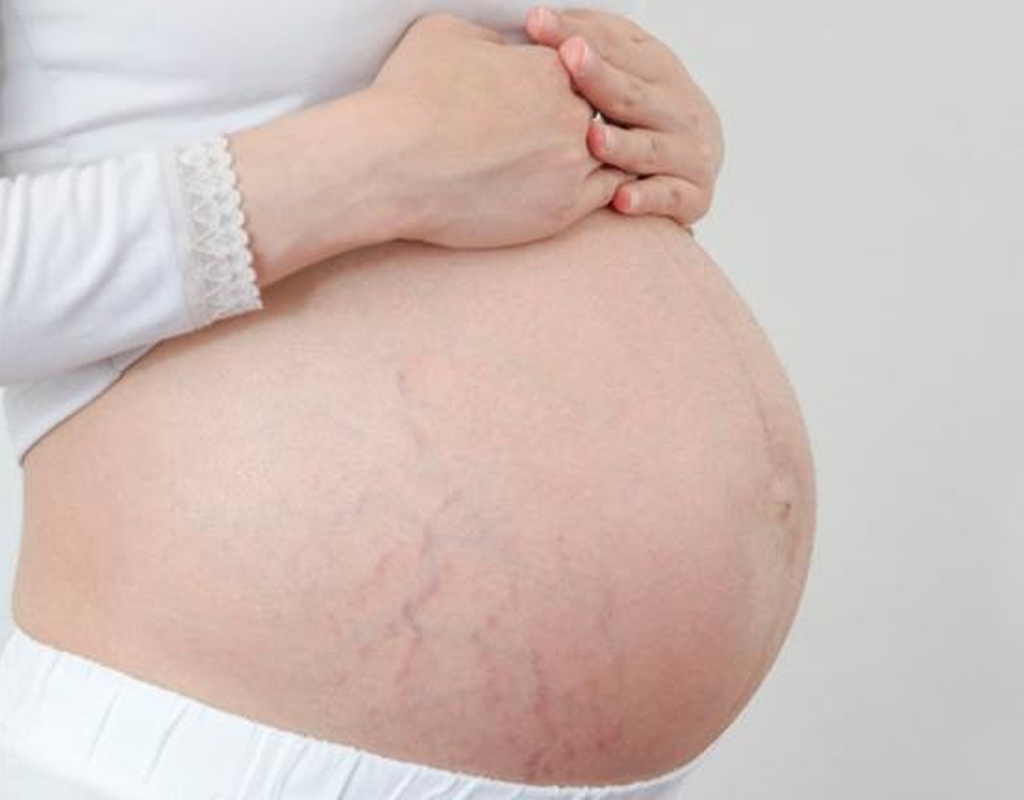Are you planning to get pregnant and worried that you will get stretch marks? You are not alone. These unsightly marks appear mainly on the abdomen, breasts, lower back, buttocks, thighs and upper arms. This common skin condition affects more than 50 percent of women and a small percentage of men. While women may be distressed by their appearance especially during pregnancy, stretch marks do not affect their health or that of the unborn baby in any way.

When Do Stretch Marks Start During Pregnancy?
In most cases, stretch marks appear later in the second trimester or early in the third trimester. However, some women may get them in the first months of pregnancy. Stretch marks develop in stages and vary in color between pink and dark brown depending on a woman’s skin color.
- 1st Stage: Light colored marks appear on the surface of the skin with the surrounding skin appearing thin and flattened. They may be itchy.
- 2nd Stage: The marks gradually enlarge both lengthwise and widthwise and become darker in color.
- 3rd Stage: As the stretch marks mature, they become less dark and usually start fading within months following childbirth. The stretch marks change in color to a pale hue and are irregularly shaped with varying lengths.
While most stretch marks appear on the woman’s stomach during pregnancy, they may also develop on other parts of the body especially those with fat deposits, including breasts, hips, lower back, buttocks and thighs.
What Causes Stretch Marks? Will Everybody Have Them?
Besides wondering “When do stretch marks start during pregnancy?” you may want to know their cause and whether you will automatically have them. Stretch marks during pregnancy, also known as striae gravidarum, are thought to occur due to the following two factors:
- Physical stretching of skin during pregnancy, which may also happen in cases of fast weight gain, including adolescence. Skin adjusts to cope with ordinary movements through expansion and contraction. However, when the change is continuous and fast such as the expansion during pregnancy or adolescence, the skin is unable to cope seamlessly. This leads to some tearing and scarring thereby forming stretch marks.
- According to some experts, elevated hormone levels may be responsible for stretching of skin to form stretch marks. The argument is that some of these hormones cause an increase of water in the skin, thereby loosening collagen fibers such that their bonds are weaker and subject to skin tear due to stretching.
Who Gets Stretch Marks?
Studies show that 90 percent of women get stretch marks when they are 6- or 7-months pregnant. Additionally, a woman is more likely to get them if her mother had them.
Your compression will normally determine the color of your stretch marks with light skinned women developing pink lines while women with darker skin get marks that are lighter than their skin color.
How to Deal with the Stretch Marks
While you may still wonder “When do stretch marks start during pregnancy?” and notwithstanding that they have a genetic factor, you can keep their effect on your image to a minimum in the following ways:
- Moisturize. Keep your skin moisturized by applying a moisturizer like cocoa butter every day. While it is not a cure, it will reduce dryness and any itchiness that may come with stretch mark development. You could also enjoy the feeling of having your partner massage the cream on your growing stomach.
- Nourish your skin from the inside. Take foods rich in vitamin C to boost your health during pregnancy, including toning your skin so that it is less susceptible to developing stretch marks.
- Watch your weight. While you eat for two during pregnancy, you don’t have to overdo it. Aim to include the recommended food groups in your diet in reasonable amounts. This way, you will put on additional weight steadily, not in spurts.
- Wait it out. Don’t be too hard on yourself if the stretch marks are still there even when you do everything right. Take it gracefully and wait for them to clear. Remember that although a dermatologist may offer treatment options like laser therapy and retinol-A, these are not advisable especially during pregnancy.
Can I Prevent Stretch Marks?
This is not possible. While nobody wants to have them, there’s no known way to prevent them especially during pregnancy. It is therefore unnecessary to spend time searching for possible treatments. The best approach is to wait for childbirth, then you can go to the spa or get the occasional massage.
When Can I Expect My Stretch Marks to Go Away?
It is easier to answer the question, “When do stretch marks start during pregnancy?” than “When they will go away?” Because your skin will take time to recover, the stretch marks will be around for a while after your child is born. But they will be less prominent as their color changes to a hue close to your compression. You can also take pride in them as a sign of the accomplishment of childbirth.
